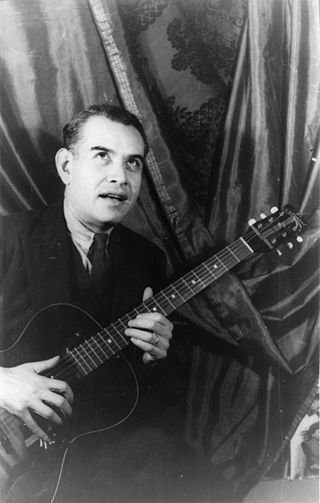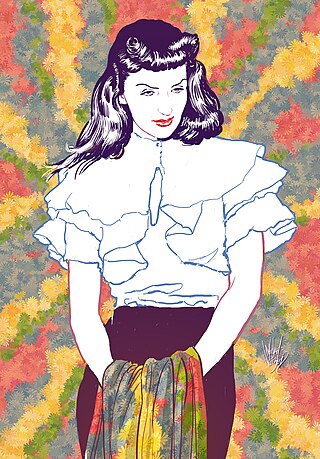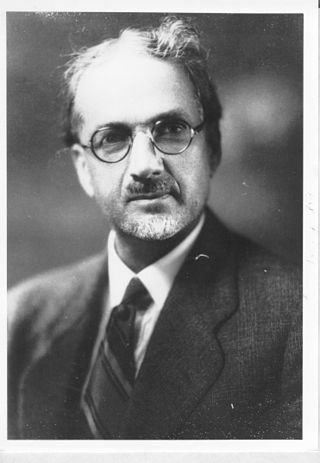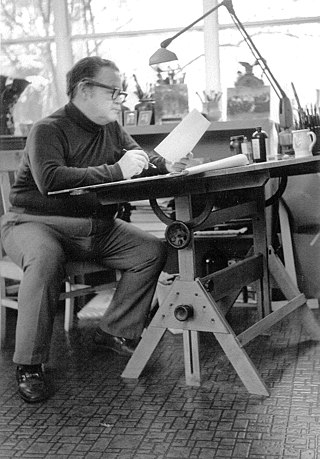Related Research Articles

Printmaking is the process of creating artworks by printing, normally on paper, but also on fabric, wood, metal, and other surfaces. "Traditional printmaking" normally covers only the process of creating prints using a hand processed technique, rather than a photographic reproduction of a visual artwork which would be printed using an electronic machine ; however, there is some cross-over between traditional and digital printmaking, including risograph.

Monotyping is a type of printmaking made by drawing or painting on a smooth, non-absorbent surface. The surface, or matrix, was historically a copper etching plate, but in contemporary work it can vary from zinc or glass to acrylic glass. The image is then transferred onto a paper by pressing the two together, using a printing-press, brayer, baren or by techniques such as rubbing with the back of a wooden spoon or the fingers which allow pressure to be controlled selectively. Monotypes can also be created by inking an entire surface and then, using brushes or rags, removing ink to create a subtractive image, e.g. creating lights from a field of opaque colour. The inks used may be oil or water-based. With oil-based inks, the paper may be dry, in which case the image has more contrast, or the paper may be damp, in which case the image has a 10 percent greater range of tones.

Agnes Bernice Martin was an American abstract painter known for her minimalist style and abstract expressionism. Born in Canada, she moved to the United States in 1931, where she pursued higher education and eventually became a U.S. citizen in 1950. Martin's artistic journey began in New York City, where she immersed herself in modern art and developed a deep interest in abstraction. Despite often being labeled a minimalist, she identified more with abstract expressionism. Her work has been defined as an "essay in discretion on inward-ness and silence".

Rufino del Carmen Arellanes Tamayo was a Mexican painter of Zapotec heritage, born in Oaxaca de Juárez, Mexico. Tamayo was active in the mid-20th century in Mexico and New York, painting figurative abstraction with surrealist influences.

Mary Blair was an American artist, animator, and designer. She was prominent in producing art and animation for The Walt Disney Company, drawing concept art for such films as Alice in Wonderland, Peter Pan, Song of the South and Cinderella. Blair also created character designs for enduring attractions such as Disneyland's It's a Small World, the fiesta scene in El Rio del Tiempo in the Mexico pavilion in Epcot's World Showcase, and an enormous mosaic inside Disney's Contemporary Resort. Several of her illustrated children's books from the 1950s remain in print, such as I Can Fly by Ruth Krauss. Blair was inducted into the group of Disney Legends in 1991.
Monoprinting is a type of printmaking where the intent is to make unique prints, that may explore an image serially. Other methods of printmaking create editioned multiples, the monoprint is editioned as 1 of 1. There are many techniques of mono-printing, in particular the monotype. Printmaking techniques which can be used to make mono-prints include lithography, woodcut, and etching.
Latin American art is the combined artistic expression of South America, Central America, the Caribbean, and Mexico, as well as Latin Americans living in other regions.

Albert Henry Krehbiel, was the most decorated American painter ever at the French Academy, winning the Prix De Rome, four gold medals and five cash prizes. He was born in Denmark, Iowa and taught, lived and worked for many years in Chicago. His masterpiece is the programme of eleven decorative wall and two ceiling paintings / murals for the Supreme and Appellate Court Rooms in Springfield, Illinois (1907–1911). Although educated as a realist in Paris, which is reflected in his neoclassical mural works, he is most famously known as an American Impressionist. Later in his career, Krehbiel experimented in a more modernist manner.

Paul Feeley was an artist and director of the Art Department at Bennington College during the 1950s and early 1960s.

Dan Owen Dailey is an American artist and educator, known for his sculpture. With the support of a team of artists and crafts people, he creates sculptures and functional objects in glass and metal. He has taught at many glass programs and is professor emeritus at the Massachusetts College of Art, where he founded the glass program.
Jesús Reyes Ferreira, (1880-1977) born José de Jesús Benjamín Buenaventura de los Reyes y Ferreira and also known as Chucho Reyes, was a self-taught artist and antiques/art collector and vendor. Reyes Ferreira began painting on crêpe paper, a delicate material not meant to last, as a way of decorating paper meant to wrap sales from his antiques/art store. The decorated paper became popular enough to be sold on its own. Although he began this activity in Guadalajara, he did not produce the bulk of his work until after he moved to Mexico City when he was 58 years old. Here he continued collecting and selling objects such as colonial art and Mexican handcrafts and folk art, being one of the early exponents for the appreciation of these objects. He also spent several hours a day painting. His work was first exhibited in 1950 with his first individual exhibition in 1967 at the Palacio de Bellas Artes after a half century of painting. As a self-taught painter, his works are relatively simple and often are dismissed as folk painting but they were and his aesthetics were praised by famous artists and architects at the time.

Howard Norton Cook (1901–1980) was an American artist, particularly known for his wood engravings and murals. Cook spent much of the 1920s in Europe and returned to live in Taos, New Mexico.

Sari Dienes was a Hungarian-born American artist. During a career spanning six decades she worked in a wide range of media, creating paintings, drawings, prints, sculptures, ceramics, textile designs, sets and costumes for theatre and dance, sound-art installations, mixed-media environments, music and performance art. Her large-scale 'Sidewalk Rubbings' of 1953–55 - bold, graphic, geometrical compositions, combining rubbings of manhole covers, subway gratings and other elements of the urban streetscape - signaled a move away from the gestural mark making of Abstract Expressionism towards the indexical appropriation of the environment that would be further developed in Pop art, and exerted a significant influence on Robert Rauschenberg and Jasper Johns.

James F. Walker was an American graphic artist, twice named to the 100 Best New Talent List by Art in America. Walker was particularly noted for his mixed media surrealist images, which he called "magic realism". Walker was also an influential teacher. His work has been exhibited in America, as well as in Germany and in France.
Myriam de la Riva is a Mexican artist known for her small scale works as well as portable murals. She was born in Mexico City to a European family in exile. She studied art in both Mexico and the United States as well as with a number of notable Mexican artists. The artist has had over fifty individual exhibitions and her work has been shown in over 500 collective shows. Her work has been recognized with membership in the Salón de la Plástica Mexicana, among other awards.
Mala Breuer was an American Abstract Expressionist. Her work is in the collections of the San Francisco Museum of Modern Art, Albright Knox Art Gallery in Buffalo, and the Museum of Fine Arts, Santa Fe, New Mexico.
Jack Ox is an intermedia artist and an acknowledged pioneer of music visualization.

Constance DeJong is an American visual artist who works in the margin between sculpture and painting/drawing. Her predominate medium is metal with light as a dominant factor. She is currently working in New Mexico and is a professor of sculpture at the University of New Mexico. DeJong received a National Endowment for the Arts Visual Art Fellowship in 1982. In 2003, she had a retrospective at the Albuquerque Museum of Art and History. That same year, Constance DeJong: Metal was published and released by University of New Mexico Press. Her work has been described by American art critic Dave Hickey as "work worth seeing and thinking about under any circumstances".
Nanibah "Nani" Chacon is a Diné and Chicana painter, muralist, and art educator. Her work has been installed at the IAIA Museum of Contemporary Native Arts in Santa Fe, the Navajo Nation Museum in Window Rock, the ISEA International Arts and Technology Symposium, Old Town Lansing, and in the "Que Chola" Exhibition at the National Hispanic Cultural Center in Albuquerque, among other venues.

Sandeep Mukherjee is an Indian-American artist based in Los Angeles who works in the areas of painting, drawing and installation art. His work engages with the discourses of process art, textile art, modernist abstract painting and traditional Eastern art, balancing emphases on materiality, the physicality of the performing body and viewer, architectural space, and image. He is most known for his process-oriented, improvisational abstract works—often paintings in acrylic inks and paints on textured or film-like surfaces—that seek to represent mutable, flowing matter and liminal realms between subjective experience and objective information. Mukherjee's early work was figurative; his later work, while abstract, is often likened to landscape and microscopic, natural or celestial phenomena. Los Angeles Times critic Christopher Knight described it as "ecstatic abstraction, built from color, line, movement and light. Like the dance done by a whirling dervish, who positions himself between material and cosmic worlds."
References
- 1 2 Pulkka, Wesley (June 1, 2013). "Exhibit features pioneers". Albuquerque Journal. Retrieved March 24, 2018.
- 1 2 3 Traugott, Joseph (2015). Visualizing Albuquerque. Albuquerque, NM: Albuquerque Museum. p. 100. ISBN 978-0977991082.
- 1 2 3 4 Randall, Margaret (April 13, 2015). "Visualizing Albuquerque". New Mexico Mercury. Retrieved March 24, 2018.
- ↑ "Alive Garver Exhibition Opens Today". Albuquerque Journal. March 8, 1953. Retrieved March 24, 2018.
- 1 2 Murphy, Alexa. "First National Bank Building East". Albuquerque Modernism. Retrieved March 24, 2018.
- ↑ Peterson, William (May 7, 2015). "Unfolding art in Albuquerque, part III". New Mexico Mercury. Retrieved March 24, 2018.